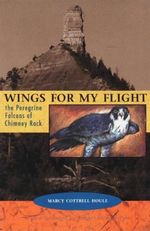Reviewed by Grant McCreary on February 22nd, 2008.
In 1975 Marcy Cottrell was “an untested wildlife biologist straight from college” and ready to begin her first study – the Peregrine Falcons of Chimney Rock, Colorado. She had no idea what she was getting into.
On the surface her assignment was simple: observe the Peregrines attempting to nest on Chimney Rock, and record their behavior. This was an important assignment, as Peregrine Falcons had been largely extirpated from their former range in the United States due to the ravages of the pesticide DDT. This pair was one of only seven left in the Rocky Mountains. Complicating the project was the logistics. By necessity she had to spend pretty much every daylight hour for over four months watching the falcons. Since this was a remote location with no amenities she was given a camper to sleep in, but one in which pretty much everything was nonfunctional. But this is what she had been trained to do, and thus even constructing and using her own pit toilet was not too much of a burden.
Unfortunately, the environment wasn’t her only impediment. There was also a great deal of resistance and hostility against both her and the birds by the locals and even the Forest Service. As the author discovered, Chimney Rock wasn’t just an ideal location for a falcon aerie; it was also an extensive Native American archaeological site. The local park service and townsfolk had grand plans to make it into a tourist attraction that would surpass Mesa Verde National Park. But they couldn’t do that if a pair of federally endangered falcons was nesting there.
The events and experiences the author recounts here range from heartwarming to heartbreaking. The interaction with the birds and other like-minded people are an absolute joy to read about. After all, these are Peregrine Falcons! I don’t know how anyone could not fall in love with these birds after watching one. “Few works of nature or man equal the sight of a Peregrine in the wind” (Pete Dunne, Hawks in Flight).
On the other hand, some of what happened is just unthinkable. Honestly, it would have been hard to get through some of it without the benefit of time. At the time the falcon’s future was in serious doubt. But today we know that these birds, while not abundant, are relatively safe. I had to keep reminding myself of that while reading parts of this book. There is tragedy, but ultimately hope.
Along the way you will also learn a good deal about Peregrines, field work, and even a little about human nature.
Not only was the story itself great, but it was also very well written. It is a quick, easy, enjoyable read (as long as you can get past the sheer stupidity and ignorance of some people in the tale). I was sufficiently impressed that the author’s subsequent book, The Prairie Keepers, immediately went on my to-read list.
This is a great story presented in a great manner and is thus highly recommended, even more so if you’re especially interested in conservation, Peregrines, or wildlife field work.
Disclosure: I get a small commission for purchases made through links in this post.






[…] my review of the author’s previous work, Wings for my Flight, I mentioned that I was sufficiently impressed with it that I wanted to read this book as well. I […]